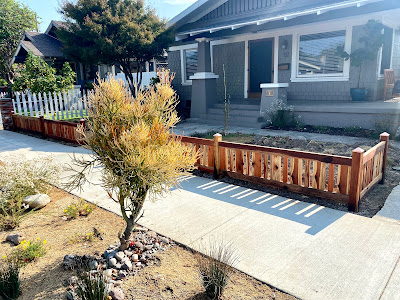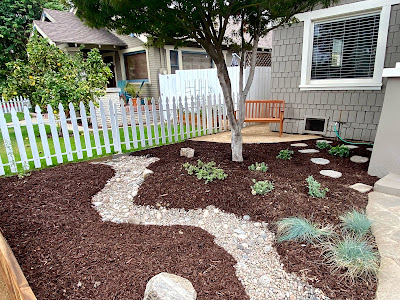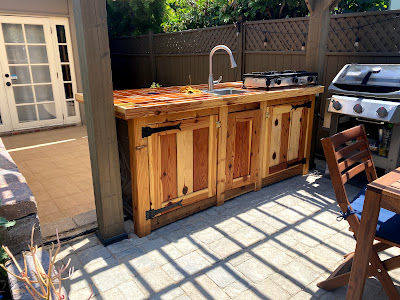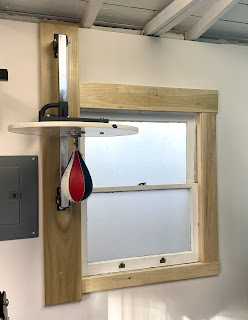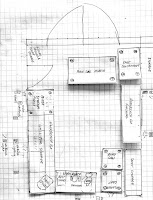Very happy to report that the landscape lighting is in! Used Volt lighting that's available at a discount for Costco members. Very high quality - forged brass lights. Very sturdy and should last a long time. All low voltage 12v system, so pretty easy to install. It really adds a lot of drama to the space and makes it "dance" at night. Fun easy project with a quick payoff.
This site celebrates living a simple lifestyle. It is about learning to live a craftsman way of life - where simplicity, handmade, community and learning are at the root of a wealthy journey.
Monday, October 4, 2021
Tuesday, September 21, 2021
Lawn2Gaden Progress
In early August 2021, we received approval to move forward with our Lawn2Garden conversion. More info on the application and process can be found in this earlier blog entry.
Once receiving approval, we quickly jumped into action to implement the following landscape plan:
We used a long bright orange extension cord to lay out the size and shape of the swales prior to digging. You can also use a water hose for this. I find this important as it will help you establish an interesting and organic shape for your landscape elements.
It is also worth mentioning that we pulled in a 12v DC low voltage cable to run future landscape lighting. We also plumbed the yard with water for any future landscaping irrigation needs. We expect that we are not going to add irrigation because we are working towards a landscape that requires watering on 30 day intervals or less. We still decided to plumb water to the area in case it is needed at some point in the future.
Once the swales and berms were established, we installed garden edging and selected landscape materials. We decided to use the following landscape materials: decomposed granite (DG), river rock (both small & large), bark mulch, and a dessert tan landscape rock. We will also use a number of small boulder rocks to add visual interest. We used a landscape edging made of carbon steel that will rust and disappear as a natural element into the landscape.
One of the biggest challenges with a lawn2garden conversion is how to get rid of the grass. We decided to use cardboard over the existing grass with both landscape rock or bark mulch over the top. The cardboard will kill the grass off underneath and it will compost into the soil. We determined this was the easiest and cheapest method for our project. We had been saving cardboard boxes for a good 6 months for this purpose. We supplemented our cardboard supply with a number of cheap moving boxes we picked up at Home Depot.
For the swales, we lined them with landscaping fabric prior to pouring in the rock. Pulling weeds out of rock is not a fun process and we decided that landscape fabric was the way to go for this area. However, we only used the landscape fabric in as few places as possible because we want the native plants to be able to spread and develop root systems without being impeded.
Before:
After:
We are extremely happy with the results. The berms adds a lot of visual interest and texture. We are excited about the swales and think they are both visually interesting and useful to capture rain water. The fence adds a beautiful design element that defines the space and harmonizes with the style of the house.
We are excited to begin planting. Earlier this week we reviewed our plant selections and will be making some changes. We found that the design on paper isn't an exact match to the physical space and therefore needs some minor tweaks. Be sure to allow yourself enough flexibility to evaluate your plan along the way. Seeing is believing and designs are meant to evolve. We expect to start planting in October and will post updates as that progresses.
From a timing perspective we have spent approximately 20 hours on our DIY front yard conversion. From a financial perspective, we have spent somewhere in the neighborhood of $700 on fencing materials and hardscaping supplies. Most all landscape supplies were purchased at our local Lowes.
It is all working! We've had so many people stop by wondering what we're doing and asking questions. We’re doing Lawn2Garden of course! Amazing to see so many people interested, and we hope our project can act as inspiration for others considering similar projects. Save water and beautify all at the same time!
Thursday, August 5, 2021
Summertime Highlights
In addition to constantly working on our 1914 craftsman four-square, we do sometimes just step back and enjoy what we've accomplished. It seems lately that maybe we don't take the time to do that enough. Perhaps it is a pandemic related behavior?
The native plant landscape we planted in the Fall-Winter-Spring season of 2020/21 really leapt to life! Here are some photos to show the progress:
In line with our need to enjoy life more and not to just work all the time -- we built an outdoor bar as part of our botanical entertainment backyard complex :). This project tested our tile and woodworking skills and we couldn't be happier with the end result.
Hope readers are enjoying the summer as we are. Keep keeping on.
Thursday, July 29, 2021
Lawn2Garden
Earlier this year I wrote about the Lawn2Garden effort to convert our remaining grass lawn into planted landscape area. Since then, I've decided to leverage the Long Beach Lawn to Garden program to complete this conversion and to see what the process is like to leverage this resource. The conversion was something we were planning to do with or without the official city program, but I felt that it would be worth it to document the experience so that others can benefit from this information.
In June of 2021 I submitted the Lawn2Garden application for our 271 square feet of grass and it was quickly approved. California is in the throws of a very extensive drought, and I cannot in good conscious continue to pour water on the lawn. I personally don't find the aesthetics of a lawn to be very appealing in Southern California as it doesn't match the landscape or draw cues from it in any way. At the same time, it will allow the front-yard to match the work we've done in the backyard so that there is more cohesion.
With the approval from the Long Beach Water departments Lawn2Garden conversion in hand, we set off to complete the final drawing for the front-yard conversion. We leveraged most of the same plants we used in the backyard when we worked with Randi at Tree of Life nursery to complete that design. The numbers on the design correspond to the ID numbers on this plant list, which also shows watering requirements. On the plant list, reference the 'Front Yard' sheet. The plant selections changed very little from our backyard plant palette and that was completely by design. First, we've had very good luck with all the plants we used in the backyard and have lost very few. In addition, using most all of the same plants will help ensure a high-level of cohesion from front to back.
Enough talking and more pictures:
Why such good luck with the backyard plants? We planted in November of 2020 right prior to what rain we did receive that winter. That proved to be very smart. The plants thrived in the cooler temps and set roots very quickly. Many sprang up and grew like crazy during the spring of 2021. Some of the most vigorous were as follows:
- Dana Point Buckwheat
- White Sage
- Yerba Buena
- Calylophus Hartwegii
- Ray Hartman Ceanothus
Sunday, June 20, 2021
Yep, more paint stripping
In October 2020 we started the ever so fun job of paint stripping our dining room. Here we are, June of 2021 and slowly but surely we're making process. We started and completed numerous other projects in this time. Paint stripping is one of those projects that just keeps giving week after week after week after week.
Earlier this year we discovered that the wall frame and panel was solid wood. That significantly increased the scope of surface area to be paint stripped and refinished. The following are the most recent progress pictures.
We dream of having this room fully done sanded and refinished by December, in time for a nice holiday party to show off the hard work.
Thursday, February 18, 2021
Slow Painful Progress
We are making slooooooooooooow painful progress stripping the original built-in cabinet. Progress is extremely slow even with the Speedheater. We learned during the process that the entire cabinet and all of the surrounding trim on the wall had been completely sanded down to raw wood. We guesstimate this happened sometime in the 50s or 60s based on the nature of the oil based paint layers. The extremely strong oil based paints made a VERY STRONG bond to the wood grain making it next to impossible to remove the paint.
Throughout this process we have been using the Speedheater to remove as much paint as possible without damaging the wood. When we scrape with too much pressure we gouge the wood, which we've done in a number of places. That will lead to more sanding and difficulty during the finishing process. We have resorted to using chemical stripper to remove the final layers of oil paint that have adhered to the raw wood. We are using Multi-Strip Advanced, which I have used in the past. It is less toxic, but still pretty strong stuff. The trick has been to leave the stripping paste on the surface for at least 10 hours before the final scrape. It leaves quite a bit of paint residue, but we expect to be able to sand most of it out during the final finishing stage.
The good news is that we did a test run on the box beams and surrounding trim in the dining room and the original finish was not sanded off. The Speedheater penetrates through the paint layers, softens the shellac layer, and the paint slides off like butter. We are hoping that this cabinet and surrounding trim is the last of the sanded wood work. Why would anyone bother to sand all of this and then cover it all up with paint? Not sure we'll ever understand exactly what happened here. The mysteries of an old house!
Tuesday, February 9, 2021
Another Win in the Finish Column
We took another project over the finish line this weekend! This one wraps up the workshop makeover we started in January. We got the workbenches and a really nice tool chest installed which mostly completes the space. This small space was a big challenge, but we couldn't be happier with the outcome. It is bright, well organized, and allows us to easily set up different tools depending on the type of project we are working on. It is really nice to have this complete! The sad part of finishing this means we have to stop procrastinating and start paint stripping the woodwork in the house again. I'd rather do just about ANYTHING else .... :-)
Saturday, February 6, 2021
Lawn to Garden
After numerous walks around our neighborhood we have been considering a lawn to garden conversion. There are quite a few people in our area that have done this. Anyone else reading this blog been through this process in another city or in Long beach? The city here offers a program to do this which includes a 3$ per sq ft grant. The city recently replaced our street and curbs, and our front strip got pretty torn up in the process. In addition, they took out the 40 foot tall eucalyptus tree that was located in the front yard along the sidewalk. This has been an invitation for us to consider what to do with the small front-yard space.
I did a first draft landscape drawing of what it could look like should we choose to go this route. Plants corresponding to the numerical identifier on the drawing can be found here. I can't help but think that this would be much more visually interesting and require a lot less water.
Trying to convince myself not to do the conversion this year, but who am I kidding. I might have this done next week :)
Wednesday, February 3, 2021
Final Push to the Finish
Why is it that the final 10% of work on a project always takes such a massive effort to finish? Perhaps because it is always detailed, or maybe it's the mental difficulty of pushing past the finish line. Nonetheless, our studio makeover project was no exception to this rule. It was one of the first projects to be started in January of 2020 and yet we just pushed it over the finish line this month!
I am proud to report that all the door and window trim is in! Even the baseboards are hung :). We trimmed the doors/windows using poplar and left it natural with a shellac finish. We used the newly acquired planer to custom mill the board depths to match the craftsman detail of the house. Overall, very pleased with the outcome and happy to have this marked off the list. The project was an excellent test of the workflow of the newly remodeled workshop and we are pleased with the result. Looking forward to moving on to a different room now...
Tuesday, January 26, 2021
Workshop Refresh
Saturday, January 2, 2021
Winter Planting
We've been focused on the landscape plantings to capitalize on the cooler temperatures and what little rain we've been receiving this winter. Having grown up in the midwest, I'm still adjusting to the climate in southern California and the idea that some plants grow all year long.
We visited the Theodore Payne Center just north of Burbank today. Much of the gardens are closed, but the plant nursery is open. Today we found the following plants on our list:
- Juncus Patens, both Elk Blue and Occidental Blue
- Bouteloua Graciis
- Heuchera 'Opal'
- Gambelia Speciosa, Firecracker
- Ceanothus Joyce Coulter




